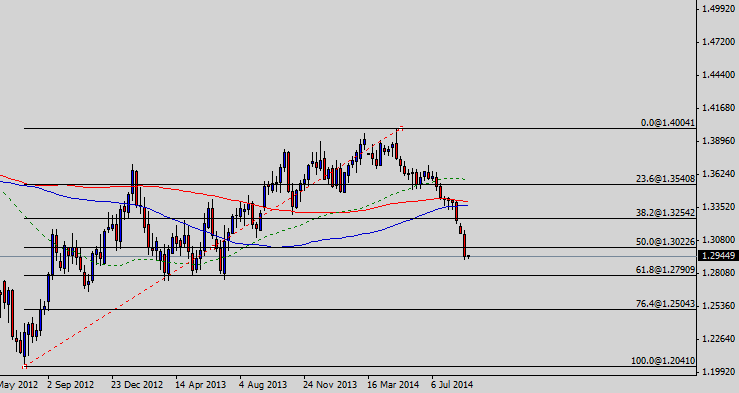FXOpen
The Euro (EUR) extended steep losses against the US Dollar (USD) on Monday, declining the price of EUR/USD to less than 1.2951 following the release of some key economic events. The bias has already turned to bearish due to Lower Low in the recent correction wave.
Technical Analysis
As of this writing, the pair is being traded around 1.2952. A support can be noted near 1.2900, the psychological number ahead of 1.2790, the confluence of 61.8% fib level and strong horizontal support as demonstrated in the following chart.
On the upside, the pair is expected to face a hurdle near 1.3026, the 50% fib level ahead of 1.3175, the low of October 1st 2013 and then 1.3254, the 50% fib level and then 1.3254, the 38.2% fib level. The bias will remain bearish as far as the 1.3700 resistance area is intact.
Germany’s Trade Balance
The trade surplus of Germany remained Euro 22.2 billion in July as compared to Euro 16.4 billion in the month before, a government report revealed today which exceeded the average forecast of Euro 16.8 billion. Generally speaking, higher trade surplus figure is considered positive for the economy thus a better than expected actual outcome spurred moderate bullish momentum in the price of EUR/USD.
Unprecedented ECB
The European Central Bank (ECB) last week surprised everybody by taking the unprecedented steps to save the shared economy from a deeper recession. The ECB lowered the benchmark interest rate to a record low level of 0.05% and also announce the asset purchase program, commonly known as Quantitative Easing or QE. The ECB announcements triggered huge selling pressure in the price of EUR/USD, opening doors for the old levels below the 1.3000 handle.
Conclusion
Considering the oversold sentiment in the price of Euro, we expect a limited pullback from the current levels, so buying the pair can be a good option if we see some real bullish signs in the form of bullish pin bar or bullish engulfing candle.
Trade over 50 forex markets 24 hours a day with FXOpen. Take advantage of low commissions, deep liquidity, and spreads from 0.0 pips. Open your FXOpen account now or learn more about trading forex with FXOpen.
This article represents the opinion of the Companies operating under the FXOpen brand only. It is not to be construed as an offer, solicitation, or recommendation with respect to products and services provided by the Companies operating under the FXOpen brand, nor is it to be considered financial advice.
Stay ahead of the market!
Subscribe now to our mailing list and receive the latest market news and insights delivered directly to your inbox.









